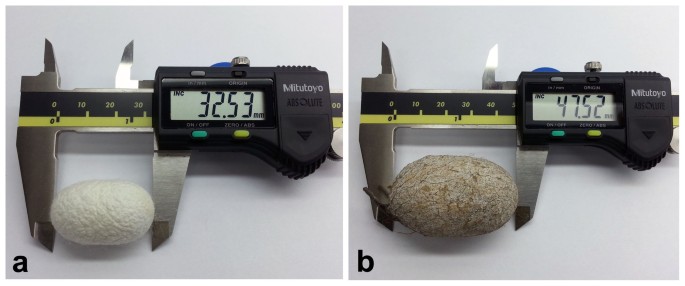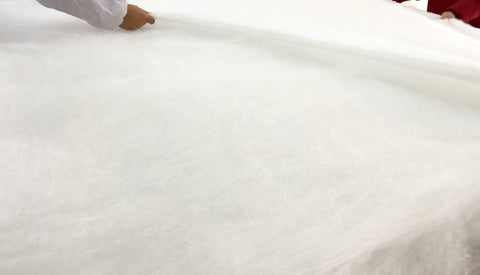I have been curious what properties silk may have which gives it the anti-EMF effects the Cs recommend it for. I did not find anything about it until now. Here is an interesting research paper:
Electricity from the Silk Cocoon Membrane
Two types of silk cocoons are used in electrical experiments. One is the most common type, Bombix Mori which feeds on Mulberry leaves. The other kind is Tasar, which as an interesting detail has an outer coating of calcium oxalate crystals. I wonder if this has anything to do with how the Cs emphasize mulberries in connection with silk.
As far as the experiments performed both types are very similar.
Apparently silk is mostly protein, which contains various minerals such as potassium, sodium, magnesium, calcium etc. The Tassar silk has higher concentrations of copper.
This is a really weird research paper though, because they construct some device which is presumed to show unique properties of silk and then at the end they do the same thing with paper with what looks like the same results. It seems like they just hopped onto the eco-friendly slant just to get their paper views. The main idea seems to be that a moisture gradient through the cocoon causes an electrical charge. But according to their own paper it seems this is not any different than paper.
It looks to me like silk is more conductive than air in humid conditions and this would translate into a faraday-cage like effect at low frequencies. It depends on moisture level so skin contact may be an important factor. I just did an informal test and while the resistance of the silk shirt I'm wearing is too high to measure and it doesn't have any significant capacitance, so I doubt it has much EMF blocking ability. Maybe for ELF. I tried again with the NFC panel on our smart washer (we went with NFC rather than Wifi). The silk shirt had absolutely no effect on the EMF meter no matter how I tried.
However the citations in this paper lead to a lot of other interesting research on silk.
Figure 2: Isolation and characterization of the UV absorbing fluorophore derived from the surface of the silk cocoon and pupae.
Apparently a silk cocoon has a chemical which converts UV light into visible light somewhere between violet and indigo. It also has impressive thermal regulation properties in maintaining a stable temperature inside. I don't know if that translates into clothing after the thread cleaning and processing though.
It is interesting that silk fiber is mostly protein, and the Cs say that proteins are antennas. If silk has an EMF protective effect then I think we may want to look elsewhere than it's electrical properties. Perhaps it has an effect on the light that reaches the skin, or has a useful effect on pollutants.
Electricity from the Silk Cocoon Membrane
Two types of silk cocoons are used in electrical experiments. One is the most common type, Bombix Mori which feeds on Mulberry leaves. The other kind is Tasar, which as an interesting detail has an outer coating of calcium oxalate crystals. I wonder if this has anything to do with how the Cs emphasize mulberries in connection with silk.
As far as the experiments performed both types are very similar.
Apparently silk is mostly protein, which contains various minerals such as potassium, sodium, magnesium, calcium etc. The Tassar silk has higher concentrations of copper.
This is a really weird research paper though, because they construct some device which is presumed to show unique properties of silk and then at the end they do the same thing with paper with what looks like the same results. It seems like they just hopped onto the eco-friendly slant just to get their paper views. The main idea seems to be that a moisture gradient through the cocoon causes an electrical charge. But according to their own paper it seems this is not any different than paper.
It looks to me like silk is more conductive than air in humid conditions and this would translate into a faraday-cage like effect at low frequencies. It depends on moisture level so skin contact may be an important factor. I just did an informal test and while the resistance of the silk shirt I'm wearing is too high to measure and it doesn't have any significant capacitance, so I doubt it has much EMF blocking ability. Maybe for ELF. I tried again with the NFC panel on our smart washer (we went with NFC rather than Wifi). The silk shirt had absolutely no effect on the EMF meter no matter how I tried.
However the citations in this paper lead to a lot of other interesting research on silk.
Figure 2: Isolation and characterization of the UV absorbing fluorophore derived from the surface of the silk cocoon and pupae.
Apparently a silk cocoon has a chemical which converts UV light into visible light somewhere between violet and indigo. It also has impressive thermal regulation properties in maintaining a stable temperature inside. I don't know if that translates into clothing after the thread cleaning and processing though.
It is interesting that silk fiber is mostly protein, and the Cs say that proteins are antennas. If silk has an EMF protective effect then I think we may want to look elsewhere than it's electrical properties. Perhaps it has an effect on the light that reaches the skin, or has a useful effect on pollutants.


